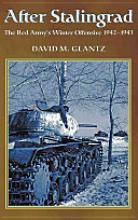After Stalingrad

Reviewed by Steven Douglas Mercatante [1]
The war between Nazi Germany and the Soviet Union has received an uneven treatment from most popular historians. Perhaps no better example of this is in typical accounts of events taking place during the winter of 1942-1943. Most often, this period of the war in Eastern Europe is described strictly from the perspective of the German Sixth Army's collapse at Stalingrad. Then, in these accounts and almost as an afterthought, the Red Army ends up pushing a reconstituted German Army Group South back into the Ukraine, and out of the Caucuses and Donbas regions of Southern Russia. The Red Army's effort during this period is maximal and concentrated almost exclusively on Army Group South. These accounts finish by describing Manstein's brilliant counter strokes in February and March of 1943 and then go into the "build up period" before Kursk. As revealed by David M. Glantz in AFTER STALINGRAD: The Red Army's Winter Offensive 1942-1943, such accounts are not only misleading, but also do a tremendous disservice to our understanding of the Second World War.
AFTER STALINGRAD: The Red Army's Winter Offensive 1942-1943 sheds new light on not only events in Southern Russia during the winter of 1942-43, but also the fierce combat that took place across the German Eastern Front during the same period. Glantz has mined newly revealed primary source material from the Russian archives to produce a fresh look at this important time in the war. Most importantly, Glantz helps clear up past myths by showing the reader the incredibly ambitious strategic intent behind Stavka's 1942-1943 winter campaign. Contrary to past descriptions, the Red Army did not merely conduct an opportunistic follow up to Stalingrad focused primarily on Army Group South. Instead, as Glantz convincingly demonstrates, Stalin and Stavka planned and launched a series of strategic level campaigns across nearly the entire front - with every major German army group the target of Soviet goals far more ambitious than previously thought.
The dedicated Eastern Front enthusiast will recognize much in this book - for instance Glant'z exploration of Operation Mars - Zhukov's highly ambitious late 1942 attempt to eviscerate German Army Group Center. Nonetheless, there is also quite a bit that may be new to even the well read. For instance, it is in how Glantz frames the larger context of his work and explores other lesser-known Soviet campaigns that he illuminates the how and why behind these important events. Beyond revisiting Operation Mars, Glantz also not only covers the Soviet thrusts into the Ukraine but also explores the ambitious February 1943 strategic level offensives Stavka launched along the Orel-Smolensk Axis and against Army Group North in Operation Polar Star - offensives frequently ignored by the traditional focus on Manstein's contemporaneous counterstrokes in the Donbas and at Kharkov. Finally, Glantz concludes with an interesting reexamination of the importance and impact produced by Manstein's highly aggressive and brilliant moves in the Ukraine.
AFTER STALINGRAD: The Red Army's Winter Offensive 1942-1943 is a must read for the dedicated student of the Second World War. That said it is not an easy read. This is a book for those with a pre-existing base of knowledge about German-Soviet war and it is not for the beginner. Although short on pictures, the book is well organized and includes numerous maps - albeit some of the maps are incredibly difficult to read. However, if you have any interest at all in the German Eastern Front during World War II than this book is for you. In addition, you can trust it's contents.
All too often publishers release books about the German Eastern Front that contain gross inaccuracies and bias with almost no attribution for where the author's statements come from. With a David Glantz book, dry as many of these may be, you are getting the best possible knowledge about the German-Soviet war found today in the English-speaking world. David Glantz is the foremost specialist on the Red Army in the Anglo-American world and ranks among the best the world over. He more than makes up for an academic writing style by putting his name to some of the finest research and unbiased historical work that can be found about the Second World War. Beyond After Stalingrad, I whole-heartedly recommend almost all of his other works. Glantz's output has been truly prodigious over the past two decades; he is the author of dozens of books and other such publications on the Red Army and the Second World War. When examining what Glantz has uncovered prepare to have your pre-existing vision of the Second World War's Eastern Front challenged, and be ready to reappraise what you thought you knew about the war.
1.Steven Douglas Mercatante's Why Germany Nearly Won, A New History of the Second World War in Europe, is currently scheduled for publication by ABC-CLIO's Praeger early in 2012. Why Germany Nearly Won not only explores how close Germany actually came to winning the Second World War, but also why Germany was defeated. This work stems from over two decades researching and studying the Second World War. Steven's writing in the historical field goes beyond his research, and draws upon his experience as a former history teacher, from his undergraduate studies in history at the University of Michigan, from his graduate work in history at Eastern Michigan University, and from his study of International Law at Michigan State University College of Law. Steven has been published numerous times over in the historical and financial/legal field, both online and in a scholarly journal with a 2008 article entitled; The Deregulation of Usury Ceilings, Rise of Easy Credit, and Increasing Consumer Debt, published in volume 53 of the South Dakota Law Review.



Post new comment